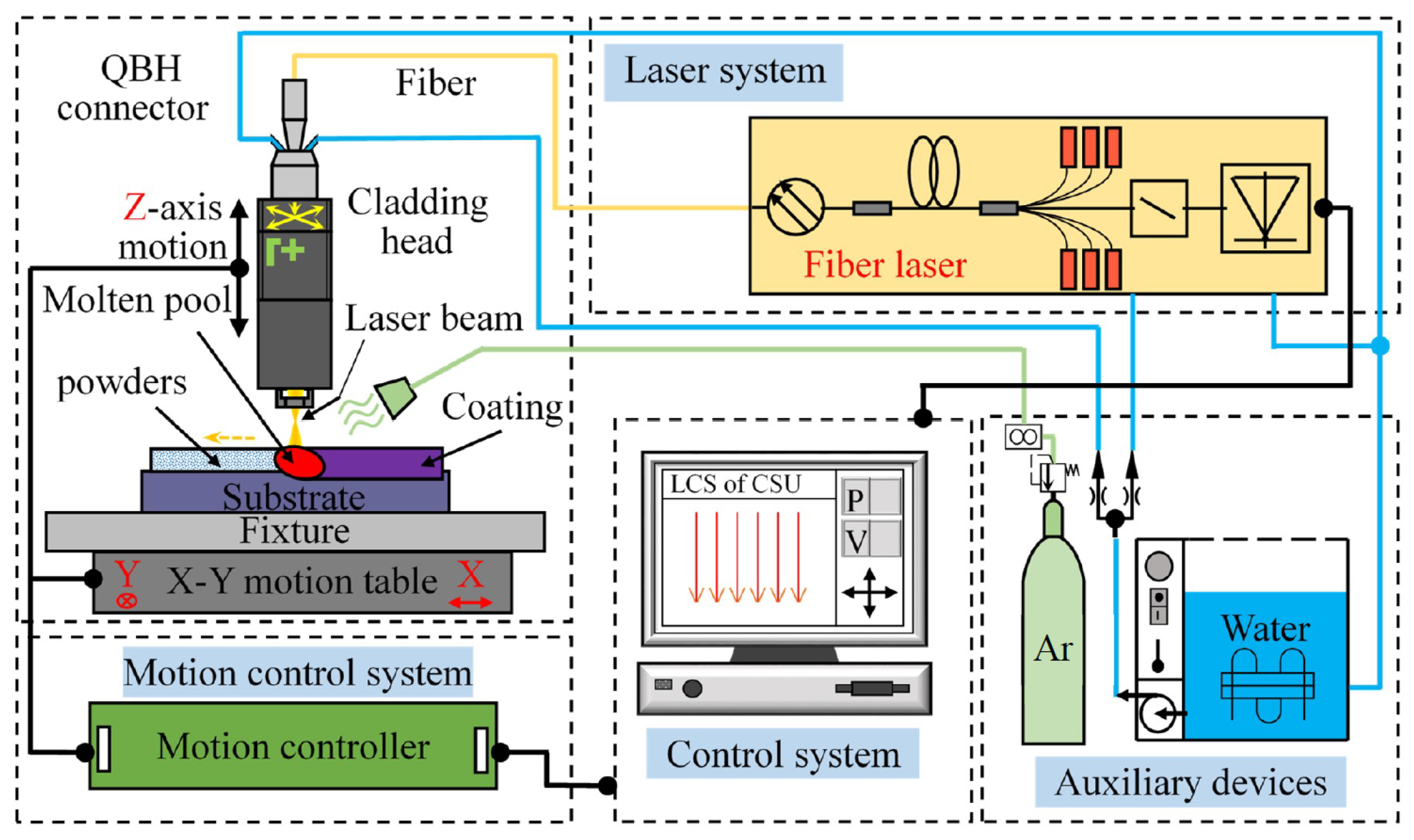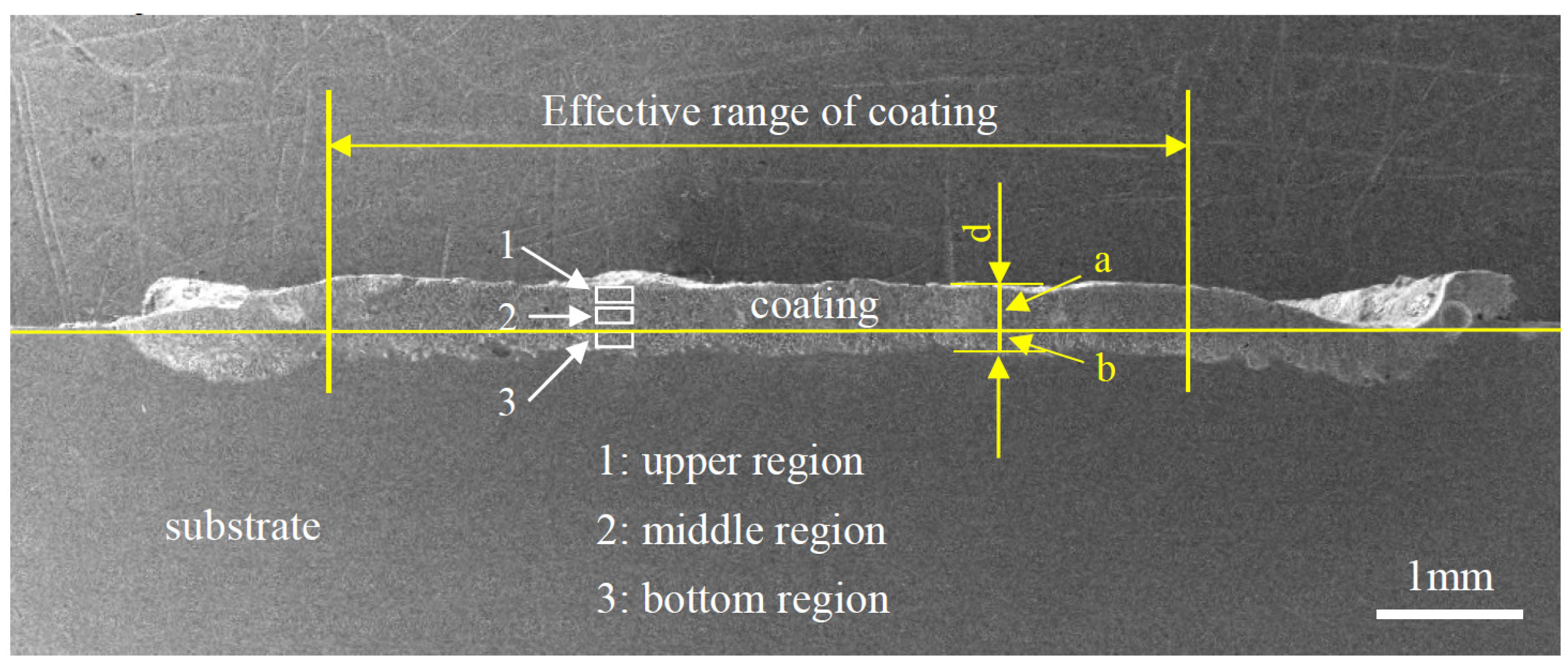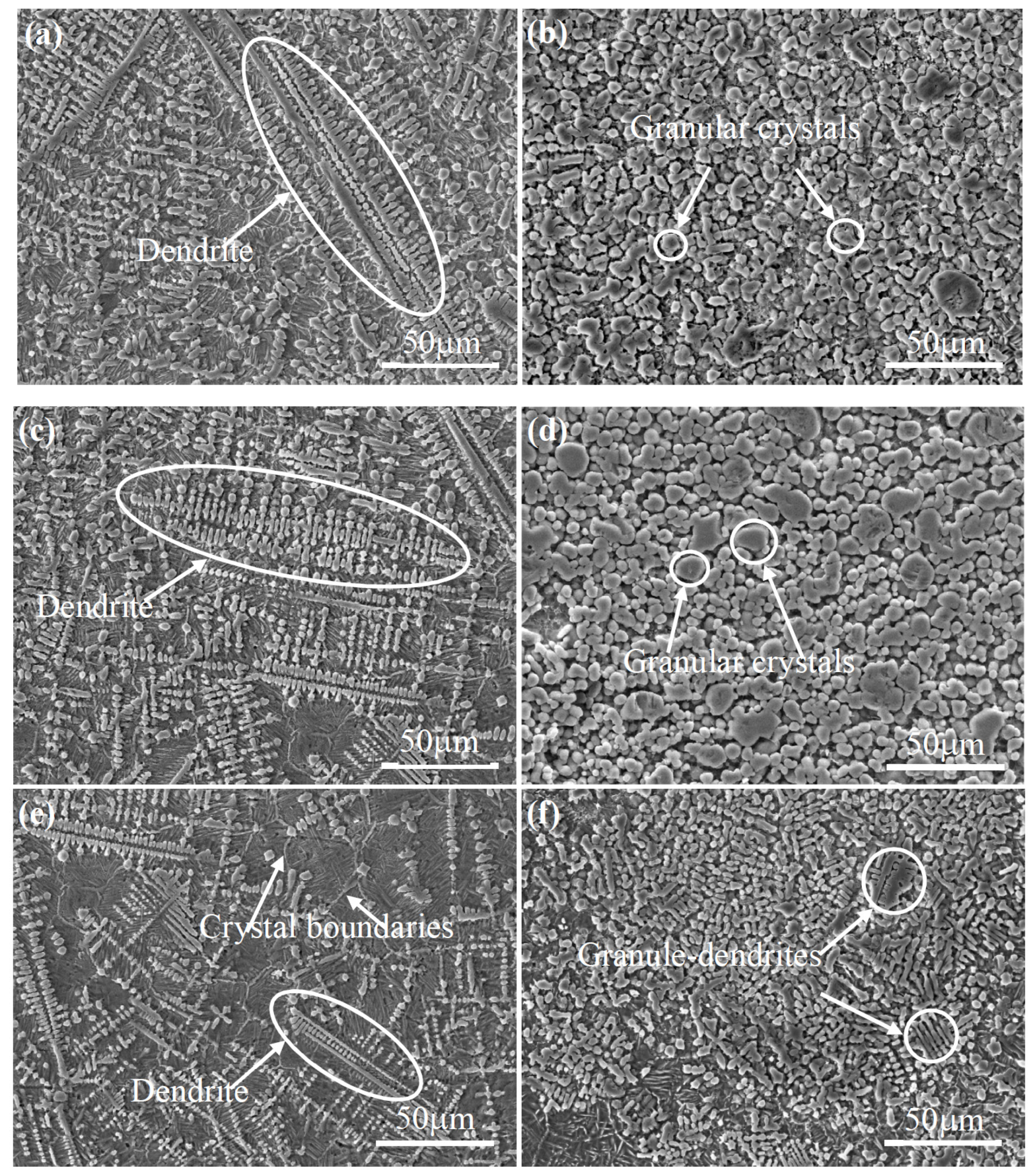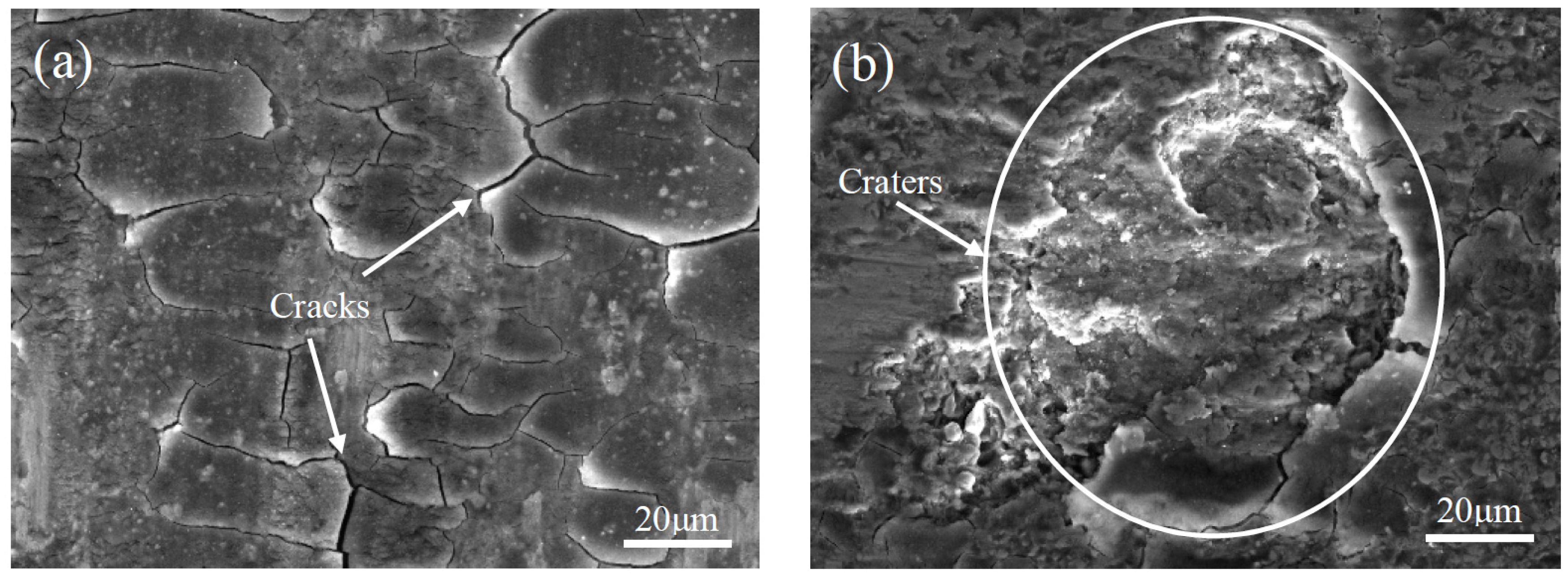Laser Cladding of Ti-Based Ceramic Coatings on Ti6Al4V Alloy: Effects of CeO2 Nanoparticles Additive on Wear Performance
Abstract
:1. Introduction
2. Materials and Methods
2.1. Materials Used and Laser Cladding Process
2.2. Test Methods of the Coating Characteristics
2.3. Wear Tests of the Coatings
3. Results and Discussion
3.1. Phases and Microstructure of the Coatings
3.2. Microhardness and Wear Resistance of the Coatings
3.3. Wear Behaviors of the Coatings
4. Conclusions
- Ti-based ceramic coatings on Ti6Al4V substrates were fabricated by laser cladding using TiCN + SiO2 mixed powder with or without adding CeO2 nanoparticles. The composites of the coatings mainly included TiCN, TiN, Ti6O, Ti3SiC2, and α-Ti phase.
- The coatings modified with CeO2 nanoparticles exhibited a better quality of microstructure. The crystalline grain morphology of the upper and middle regions of the coatings without CeO2 was dendrites, while the crystalline grain morphology of the coatings modified with CeO2 nanoparticles was granulated. Moreover, the crystalline grains of the coatings modified with CeO2 nanoparticles were smaller and more compact due to the grain refining effect of the CeO2 nanoparticles.
- The microhardness of the coatings was enhanced significantly compared to the Ti6Al4V substrate. The average values of the microhardness of the coating without CeO2 and the coating modified with CeO2 nanoparticles were approximately 1050 HV0.2 and 1230 HV0.2, respectively.
- The additive of CeO2 nanoparticles obviously improved the wear resistance of the coating under SBF wear test conditions. The wear volume loss of the coating was approximately 2.2% of the wear volume loss of the substrate after a 90-min wear test.
- The wear mechanisms of the coatings without CeO2 included abrasive wear, adhesive wear, and fatigue wear, while the wear mechanisms of the coatings modified with CeO2 nanoparticles included only abrasive wear and adhesive wear, because the refined microstructure of the coatings improved the resistance to fatigue wear.
Author Contributions
Funding
Acknowledgments
Conflicts of Interest
References
- Habibovic, P.; Li, J.P.; Valk, C.M.V.D.; Meijer, G.; Layrolle, P.; Blitterswijk, C.A.V.; Groot, K.D. Biological performance of uncoated and octacalcium phosphate-coated Ti6Al4V. Biomaterials 2005, 26, 23. [Google Scholar] [CrossRef] [PubMed]
- Romero, C.; Yang, F.; Bolzoni, L. Fatigue and fracture properties of Ti alloys from powder-based processes-A review. Int. J. Fatigue 2018, 117, 407–419. [Google Scholar] [CrossRef]
- Banerjee, D.; Williams, J.C. Perspectives on Titanium Science and Technology. Acta Mater. 2013, 61, 844–879. [Google Scholar] [CrossRef]
- Geetha, M.; Singh, A.K.; Asokamani, R.; Gogia, A.K. Ti based biomaterials, the ultimate choice for orthopaedic implants—A review. Prog. Mater. Sci. 2009, 54, 397–425. [Google Scholar] [CrossRef]
- Budinski, K.G. Tribological properties of titanium alloys. Wear 1991, 289, 203–217. [Google Scholar] [CrossRef]
- Long, M.; Rack, H.J. Titanium alloys in total joint replacement—A materials science perspective. Biomaterials 1998, 19, 1621–1639. [Google Scholar] [CrossRef]
- He, X.J.; Zhang, X.Y.; Wang, X.; Qin, L. Review of Antibacterial Activity of Titanium-Based Implants’ Surfaces Fabricated by Micro-Arc Oxidation. Coatings 2017, 7, 45. [Google Scholar] [CrossRef]
- Rautray, T.R.; Narayanan, R.; Kim, K.-H. Ion implantation of titanium based biomaterials. Prog. Mater. Sci. 2011, 56, 1137–1177. [Google Scholar] [CrossRef]
- Surmenev, R.A. A review of plasma-assisted methods for calcium phosphate-based coatings fabrication. Surf. Coat. Technol. 2012, 206, 2035–2056. [Google Scholar] [CrossRef]
- Santecchia, E.; Hamouda, A.M.S.; Musharavati, F.; Zalnezhad, E.; Cabibbo, M.; Spigarelli, S. Wear resistance investigation of titanium nitride-based coatings. Ceram. Int. 2015, 41, 10349–10379. [Google Scholar] [CrossRef]
- Asri, R.I.M.; Harun, W.S.W.; Hassan, M.A.; Ghani, S.A.C.; Buyong, Z. A review of hydroxyapatite-based coating techniques: Sol-gel and electrochemical depositions on biocompatible metals. J. Mech. Behav. Biomed. 2016, 57, 95–108. [Google Scholar] [CrossRef] [PubMed]
- Kyzioł, K.; Kaczmarek, Ł.; Brzezinka, G.; Kyzioł, A. Structure, characterization and cytotoxicity study on plasma surface modified Ti–6Al–4V and γ-TiAl alloys. Chem. Eng. J. 2014, 240, 516–526. [Google Scholar] [CrossRef]
- Weng, F.; Chen, C.Z.; Yu, H.J. Research status of laser cladding on titanium and its alloys: A review. Mater. Des. 2014, 58, 412–425. [Google Scholar] [CrossRef]
- Chen, T.; Liu, D.F.; Wu, F.; Wang, H.J. Effect of CeO2 on Microstructure and Wear Resistance of TiC Bioinert Coatings on Ti6Al4V Alloy by Laser Cladding. Materials 2018, 11, 58. [Google Scholar] [CrossRef] [PubMed]
- Forn, A.; Picas, J.A.; Fuentes, G.G.; Elizalde, E. Mechanical and tribological properties of TiCxN1−x, wear resistant coatings. Int. J. Refract. Met. H. 2001, 19, 507–513. [Google Scholar] [CrossRef]
- Li, H.T.; Sun, P.F.; Zhu, Y.C.; Wu, M.Z.; Wang, Q. Influence of C2H2 Flows on Microstructure and Corrosion Resistance of TiCN Films Doped with Carbon Atoms. Coatings 2018, 8, 458. [Google Scholar] [CrossRef]
- Peng, Y.; Miao, H.Z.; Peng, Z.J. Development of TiCN-based cermets: Mechanical properties and wear mechanism. Int. J. Refract. Met. H. 2013, 39, 78–89. [Google Scholar] [CrossRef]
- Qi, Y.T.; Shi, H.C.; Zou, Z.D.; Hu, L.P. Microstructure and wear behavior of laser cladding Ni-based alloy composite coating reinforced by Ti(C, N) particulates. China Weld. 2008, 17, 20–23. [Google Scholar]
- Yang, Y.L.; Yan, W.; Zhang, D.; Song, G.Z.; Zheng, Y.R. In Situ-Fabrication of TiCN Ceramic Coating on Titanium Alloy by Laser Cladding Technology. Key Eng. Mater. 2010, 434–435, 485–488. [Google Scholar] [CrossRef]
- Schneider, L.C.R.; Cocks, A.C.F.; Apostolopoulos, A. Comparison of filling behaviour of metallic, ceramic, hardmetal and magnetic powders. Powder Metall. 2005, 48, 77–84. [Google Scholar] [CrossRef]
- Ku, N. Evaluation of the behavior of ceramic powders under mechanical vibration and its effect on the mechanics of auto-granulation. Ph.D. Thesis, Rutgers University, New Brunswick, NJ, USA, 2015. [Google Scholar]
- Ye, H.H.; Rixecker, G.; Aldinger, F. Liquid Phase Sintered SiC with SiO2 Additive. In Ceramics—Processing, Reliability, Tribology and Wear; Müller, G., Ed.; Wiley-VCH Verlag GmbH & Co. KGaA: Weinheim, Germany, 2006. [Google Scholar]
- Stevenson, A.J.; Kupp, E.R.; Messing, G.L. Low temperature, transient liquid phase sintering of B2O3-SiO2-doped Nd: YAG transparent ceramics. J. Mater. Res. 2011, 26, 1151–1158. [Google Scholar] [CrossRef]
- Singh, V.K. Liquid Phase Sintering of Silica. T. Ind. Ceram. Soc. 1981, 40, 44–48. [Google Scholar] [CrossRef]
- Li, J.N.; Chen, C.Z.; Zhang, C.F. Effect of nano-CeO2 on microstructure properties of TiC/TiN +nTi(CN)-reinforced composite coating. B. Mater. Sci. 2013, 36, 541–546. [Google Scholar]
- Zhao, T.; Cai, X.; Wang, S.X.; Zheng, S.A. Effect of CeO2 on microstructure and corrosive wear behavior of laser-cladded Ni/WC coating. Thin Solid Films 2000, 379, 128–132. [Google Scholar]
- Yang, Y.L.; Guo, N.; Li, J.F. Synthesizing, microstructure and microhardness distribution of Ti-Si-C-N/TiCN composite coating on Ti-6Al-4V by laser cladding. Surf. Coat. Technol. 2013, 219, 1–7. [Google Scholar] [CrossRef]
- Graciani, J.; Ma´rquez, A.M.; Plata, J.J.; Ortega, Y.; Herna´ndez, N.C.; Meyer, A.; Zicovich-Wilson, C.M.; Sanz, J.F. Comparative Study on the Performance of Hybrid DFT Functionals in Highly Correlated Oxides: The Case of CeO2 and Ce2O3. J. Chem. Theory Comput. 2011, 7, 56. [Google Scholar] [CrossRef]
- Wang, K.L.; Zhang, Q.B.; Sun, M.L.; Zhu, Y.M. Effect of laser surface cladding of ceria on the wear and corrosion of nickel-based alloys. Surf. Coat. Technol. 1997, 96, 267–271. [Google Scholar] [CrossRef]
- Li, H.C.; Wang, D.G.; Chen, C.Z.; Weng, F. Effect of CeO2 and Y2O3 on microstructure, bioactivity and degradability of laser cladding CaO-SiO2, coating on titanium alloy. Colloid. Surface B 2015, 127, 15–21. [Google Scholar] [CrossRef]
- Zhang, S.H.; Li, M.X.; Cho, T.Y.; Yoon, J.H.; Lee, C.G.; He, Y.Z. Laser clad Ni-base alloy added nano- and micron-size CeO2 composites. Opt. Laser Technol. 2008, 40, 716–722. [Google Scholar] [CrossRef]
- Ding, L.; Hu, S.S. Effect of nano-CeO2 on microstructure and wear resistance of Co-based coatings. Surf. Coat. Technol. 2015, 276, 565–572. [Google Scholar] [CrossRef]
- Feng, W.; Hai, Z.; Yang, S.Z. Nano-indentation and wear-resistance behaviors of TiCN films by pulsed plasma on cemented carbide cutting tool. Mater. Sci. Eng. A 2010, 527, 4767–4770. [Google Scholar] [CrossRef]
- Ghareshabani, E.; Rawat, R.S.; Sobhanian, S.; Verm, R.; Karamat, S.; Pan, Z.Y. Synthesis of nanostructured multiphase Ti(C,N)/a-C films by a plasma focus device. Nucl. Instrum. Meth. A 2010, 268, 2777–2784. [Google Scholar] [CrossRef]
- Seok, M.Y.; Choi, I.C.; Moon, J.; Kim, S.J.; Ramamurty, U.; Jang, J. Estimation of the Hall-Petch strengthening coefficient of steels through nanoindentation. Scripta Mater. 2014, 87, 49–52. [Google Scholar] [CrossRef]
- Li, M.X.; Zhang, S.H.; Li, H.S.; He, Y.Z.; Yoon, J.H.; Cho, T.Y. Effect of nano-CeO2 on cobalt-based alloy laser coatings. J. Mater. Process. Tech. 2008, 202, 107–111. [Google Scholar] [CrossRef]
- Wang, C.L.; Gao, Y.; Zeng, Z.C.; Fu, Y.K. Effect of rare-earth on friction and wear properties of laser cladding Ni-based coatings on 6063Al. J. Alloy. Compd. 2017, 727, 278–285. [Google Scholar] [CrossRef]
- Li, J.; Luo, X.; Li, G.J. Effect of Y2O3 on the sliding wear resistance of TiB/TiC-reinforced composite coatings fabricated by laser cladding. Wear 2014, 310, 72–82. [Google Scholar] [CrossRef]
- Long, S.L.; Liang, Y.L.; Jiang, Y.; Liang, Y.; Yang, M.; Yi, Y.L. Effect of quenching temperature on martensite multi-level microstructures and properties of strength and toughness in 20CrNi2Mo steel. Mat. Sci. Eng. A 2016, 676, 38–47. [Google Scholar] [CrossRef]
- Rynio, C.; Hattendorf, H.; Klöwer, J.; Eggeler, G. On the physical nature of tribolayers and wear debris after sliding wear in a superalloy/steel tribosystem at 25 and 300 °C. Wear 2014, 317, 26–38. [Google Scholar] [CrossRef]
- Anandkumar, R.; Almeida, A.; Vilar, R. Wear behavior of Al-12Si/TiB2, coatings produced by laser cladding. Surf. Coat. Technol. 2011, 205, 3824–3832. [Google Scholar] [CrossRef]














| Pre-Placed Powder Ingredients (wt %) | Corresponding Laser Cladding Coating Names | ||
|---|---|---|---|
| TiCN | SiO2 | CeO2 | |
| 80 | 20 | 0 | The coatings without CeO2 |
| 77 | 20 | 3 | The coatings modified with CeO2 nanoparticles |
| Test Item | XRD | SEM and EDS | Microhardness Test | Wear Test |
|---|---|---|---|---|
| Sample number | 1 | 3 | 3 | 3 |
| Laser Power (W) | Scanning Speed (mm/s) | Spot Diameter (mm) | Overlap Rate (%) | Argon Flow Rate (L/min) |
|---|---|---|---|---|
| 450 | 7 | 1 | 20 | 10 |
| Wear Time (min) | Load (N) | Rotation Speed (rpm) | Rotation Radius (mm) | Temperature (°C) |
|---|---|---|---|---|
| 30 | 20 | 200 | 5 | 36.5 ± 1 |
| 60 | ||||
| 90 |
© 2019 by the authors. Licensee MDPI, Basel, Switzerland. This article is an open access article distributed under the terms and conditions of the Creative Commons Attribution (CC BY) license (http://creativecommons.org/licenses/by/4.0/).
Share and Cite
Wang, H.; Chen, T.; Cong, W.; Liu, D. Laser Cladding of Ti-Based Ceramic Coatings on Ti6Al4V Alloy: Effects of CeO2 Nanoparticles Additive on Wear Performance. Coatings 2019, 9, 109. https://doi.org/10.3390/coatings9020109
Wang H, Chen T, Cong W, Liu D. Laser Cladding of Ti-Based Ceramic Coatings on Ti6Al4V Alloy: Effects of CeO2 Nanoparticles Additive on Wear Performance. Coatings. 2019; 9(2):109. https://doi.org/10.3390/coatings9020109
Chicago/Turabian StyleWang, Haojun, Tao Chen, Weilong Cong, and Defu Liu. 2019. "Laser Cladding of Ti-Based Ceramic Coatings on Ti6Al4V Alloy: Effects of CeO2 Nanoparticles Additive on Wear Performance" Coatings 9, no. 2: 109. https://doi.org/10.3390/coatings9020109





